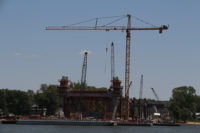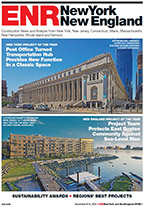The commercial categories generally lost momentum in November, even with the start of several noteworthy projects. Office construction retreated 5%, although November did include groundbreaking for a $125-million office building in Boston and a $68-million data center for Apple in Prineville, Ore. Store construction in November retreated 7%, even with the start of an $85-million outlet mall in Chesterfield, Mo., while warehouse construction dropped 15%. Hotel construction in November was down 19%, yet the month did include the start of a $183-million hotel project at Denver International Airport. The manufacturing plant category in November jumped 153% from an exceptionally weak October, although November’s pace was still 42% below the average reported for this category during the first nine months of 2012.
For the January-November period of 2012, nonresidential building was down 13% relative to the same period a year ago. The institutional sector fell 14%, as weaker activity was reported for its two largest categories—educational buildings, down 15%; and healthcare facilities, down 12%. Other institutional declines on a year-to-date basis were the following—public buildings, down 10%; churches, down 23%; and amusement-related projects, down 24%.
The manufacturing plant category year-to-date plummeted 45%, reflecting the comparison to 2011, which included a $3.0-billion coal-to-gasoline plant and two large semiconductor plants. The commercial sector year-to-date managed to increase 2%, lifted by increases for stores, up 8%; warehouses, up 9%; and hotels, up 20%.
Office construction year-to-date was down 14%, due in part to the comparison to 2011, which included the start of a $1.1-billion government data center in Utah. While the dollar amount for nonresidential building was down 13% for the first 11 months of 2012, square footage for nonresidential building was up 2% during this time.
Residential Building
Residential building in November grew 3% to $183.9 billion (annual rate). Single-family housing held steady, maintaining the improved activity reached in October, while multifamily housing climbed 17%. The multifamily increase in November was supported by the start of four condominium/apartment projects valued each at $100 million or more, located in Miami ($131 million), Boston ($116 million), Chicago ($107 million), and New York City ($100 million).
During the first 11 months of 2012, residential building advanced 28% compared to the same period a year ago. Single-family housing climbed 29%, as the result of this year-to-date performance by geography—the West, up 41%; the Midwest, up 30%; the South Atlantic, up 27%; the South Central, up 23%; and the Northeast, up 14%.
Multifamily housing rose a similar 27%, as the result of this year-to-date performance by geography—the West, up 40%; the South Atlantic, up 31%; the South Central, up 26%; the Northeast, up 25%; and the Midwest, up 12%. The top five metropolitan areas in terms of the dollar amount of multifamily starts were: New York, up 33%; Washington, D.C., up 6%; Miami, up 144%; Los Angeles, up 29%; and Boston, up 21%. The large increase for multifamily housing in the West was helped by the 29% gain for Los Angeles, as well as growth in such metropolitan areas as Seattle, up 51%; San Francisco, up 23%; Denver, up 114%; and Portland, up 79%.
The 3% pickup for total construction starts at the national level during the first 11 months of 2012 was the result of a mixed performance at the five-region level. Leading the way was the South Atlantic, up 20%, with much of the upward push coming from the start of two massive nuclear power projects in Georgia and South Carolina.
If these two projects are excluded, then total construction in the South Atlantic would be down 1%. Year-to-date gains for total construction were also reported for the South Central and the Midwest, each up 7%. Year-to-date declines for total construction were reported for the Northeast, down 5%; and the West, down 10%.



